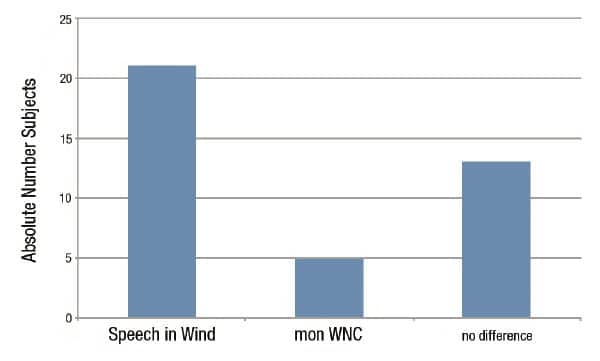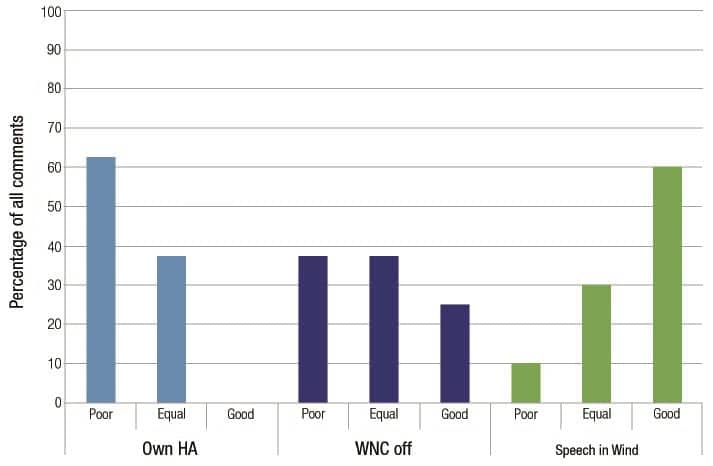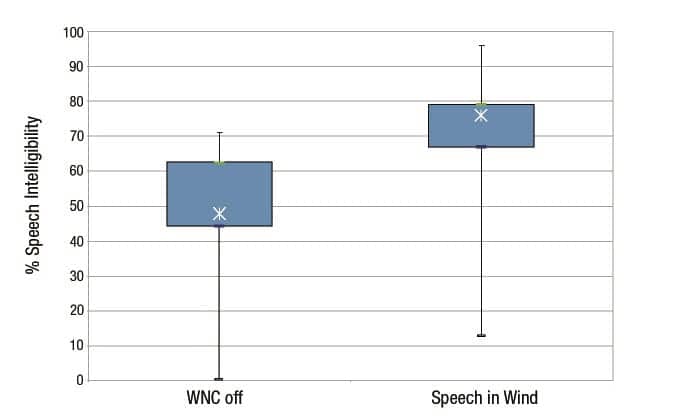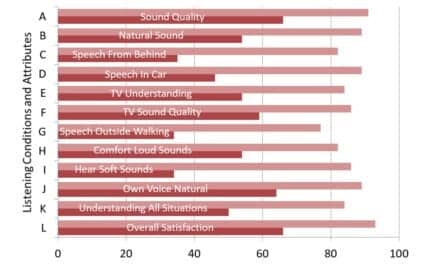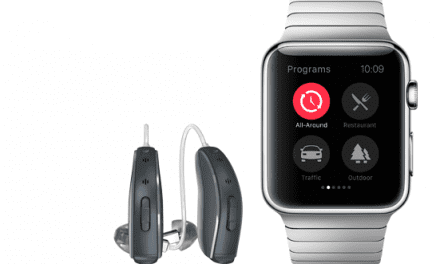By Matthias Latzel, PhD, and Jennifer Appleton, MSc
| A new algorithm has been designed to enhance speech intelligibility in wind. Last month’s Part 1 looked at performance in the laboratory; Part 2 looks at validation measures and real-life benefit of the system. |
As the number of hearing aid wearers who lead an active lifestyle is on the increase, many are now facing the challenge of listening in windy environments. Part 1 of this article,1 published in the August 2013 edition of The Hearing Review, looked at the verification of the Phonak binaural wind noise canceller (WNC), called Speech in Wind. This feature was demonstrated to attenuate low frequencies on the side where more wind is present while replacing the information with a cleaner signal from the other side where less wind is present. The goal is to improve speech intelligibility in windy situations.
Part 2 presents the results of an evaluation of the real-life benefit of this feature, by summarizing the results of tests with participants in both the laboratory and their daily life.
Clinical Validation
Speech recognition in wind for moderate hearing losses. Validation of the Speech in Wind feature was carried out in three parts. Initially, there was a validation at Phonak headquarters in Switzerland. The second and third parts were carried out at the Hearing Centre in Oldenburg, Germany, and examined the effectiveness of the feature for subjects with moderate hearing loss and severe hearing loss, respectively.
The Phonak validation trial included 44 participants with moderate hearing losses. The goal was to compare the performance of the new Quest binaural WNC with the monaural WNC from the previous generation (Spice+). A full explanation of how these different WNC systems work can be found in Part 1 of this article.1 The test setup for the validation trial is shown in Figure 1.
Participants wore two behind-the-ear (BTE) hearing aids: Spice+ monaural WNC (mon WNC) and Quest binaural WNC (Speech in Wind). For each hearing aid setup, they performed a speech test (Freiburger number test) while they were sitting in the center of the circle and facing the 0° position (Figure 1). Speech was presented at 270º to the patient and wind was presented at 60º. When facing the 0° position, the wind level was higher on the right hearing aid than on the left (asymmetrical wind condition). The Freiburger number test was chosen because this speech material has more spectral energy at low frequencies relative to other speech recognition tests.
The results of the speech test can be seen in Figure 2. There was an improvement of about 10% in speech recognition scores for the binaural WNC relative to the monaural WNC. This result is statistically significant (Wilcoxon, 0.005 significance level).
In addition to the Freiburger number test, subjective feedback from participants was obtained. In this asymmetrical wind condition, they were asked to judge for which hearing aid setup they perceived the least listening effort. The results of these subjective tests are shown in Figure 3. The majority of subjects judged the binaural Speech in Wind as requiring the least amount of listening effort.
In summary, the validation at Phonak indicated that speech recognition is significantly better using the Phonak Speech in Wind feature compared to using a monaural wind cancellation approach. Additionally, listening effort with the binaural feature is clearly reduced when listening to speech in an asymmetrical wind condition.
Judgement of Speech in Wind. Further studies were done at the Hearing Centre, in Oldenburg, Germany. The goal of the studies was to evaluate the benefit of this feature both in the laboratory and in everyday life. A total of 15 experienced hearing aid users participated in the study. All of them had a moderate-to-severe hearing loss and were males with short hair. The latter characteristic enabled the maximum amount of exposure to wind at the hearing aid microphones. All participants reported having problems with hearing or listening in wind.
At the initial appointment, subjects initially filled in two questionnaires: “General daily life—own devices” and “Wind—own devices.” Subjects were then fitted with the Phonak Spice+ hearing aids with monaural WNC active and also the Phonak Quest hearing aids. The Spice+ devices were used only in the laboratory tests and not in the real-life tests.
The subjects took the Quest hearing aids home and trialed them over a period of 2 weeks in two program settings: P1, which featured no WNC, and P2, which featured Speech in Wind. After the at-home trials, clients attended the clinic for a second session where they were asked to respond to questionnaires entitled “General Daily Life” and “Wind” with reference to hearing with the Quest hearing aids. The individual comments results of these questionnaires (including the results of the questionnaires filled in at the first session with reference to their own hearing aids) can be seen in Figure 4. When the binaural WNC was used, 60% of the comments were rated as “good” and only 10% were classified as “poor.” This is significantly better than the individual comments when no WNC was used where only 25% of comments were classified as “good” and 35% were classified as “poor.” Interestingly, with their own hearing aids, there were no individual comments classified as “good” and 62% were classed as “poor.”
Localization. It may be thought that streaming a sound signal or part of a sound signal from one ear to the other could affect the spatial cues of a hearing aid wearer, especially for localizing sound sources. Therefore, at this second clinical session, a localization test was also carried out in the laboratory to see whether the use of Speech in Wind affects localization ability more than a monaural WNC.
Figure 5 shows the test setup for this localization test. A circle with 8 loudspeakers was used to present the signals to be located (OL-noise generated from the speech material of the Oldenburg Sentence Test2 with 500ms duration). Signals were presented from either 0°, 45°, 90°, 135°, 180°, 225°, 270°, and 315°. The subjects were seated at the center of the circle and asked to use the numbers 1 to 8 (1 representing 0°, 2 representing 45°, and so on) to identify the loudspeaker position. The experimenter typed the responses into a computer.
Figure 6 shows the results of the localization test when the monaural WNC was used. A straight diagonal line (going from bottom-left to top-right) would indicate that the subject could localize the sound correctly 100% of the time. Deviations from this straight line indicate that the subject identified the sound source incorrectly. Figure 6 indicates that, even with use of the monaural WNC, there is some incorrect judgment of the sound source.
In a paper by Gitte Keidser, PhD, and colleagues,3 it can be seen in one of their figures (Figure 5 in Keidser et al) that their localization tests also resulted in a similar pattern if the data of our study are transformed to their graphical format. Keidser et al were investigating the localization ability when using a noise reduction program with comparable functionality to the WNC algorithm used in this study. Participants incorrectly judged the location of sounds—particularly near to 0°—resulting in a graph with a similar shape as to that shown in Figure 6.
Use of Speech in Wind also results in incorrect judgment of sound source (Figure 7). However, this is no worse than when the monaural WNC is used. The calculation of the Signed Mean Error4 results in similar results for both conditions (20.3° for monaural WNC and 22.5° for Speech in Wind) with no statistically significant difference. This confirms the preservation of the binaural cues even if the signal for low frequencies is almost diotic.
Speech intelligibility in the laboratory. Speech intelligibility was also measured at the second clinical session with the Oldenburg Sentence Test (OLSA)2 using “aided” dummy head recordings of the speech test signals in the laboratory wind situation. The test setup was the same as in Switzerland (Figure 1) where speech was presented via a loudspeaker at 270° and wind was presented at an angle of 60°. The recordings were then presented to real subjects via insert earphones. The reasons for not using real subjects in the test room were to minimize the duration of time that the subjects were exposed to the wind machine, and also to ensure that all subjects heard recordings which had been exposed to enough wind (wind exposure varies a lot depending on hair length and the anatomy of the ear).
Figure 8 shows the results of the speech intelligibility tests for subjects with a moderate hearing loss. It can be seen that, with Speech in Wind, subjects performed better at a statistically significant level in comparison to with “WNC off” (28% higher speech score) with much less variance. This shows that the improvement is even higher for those individuals who had poor results when the WNC was switched off.
Speech recognition in wind for severe-to-profound hearing losses. In another study at the Hearing Centre in Germany involving subjects with severe-to-profound hearing losses and the same laboratory setup (Figure 1), Speech in Wind was subjectively compared to the condition “WNC off” using relative scales.
The results can be seen in Figure 9. The overall loudness and the loudness of speech for both conditions are judged almost the same due to the sustainment of the low frequency energy. However, the loudness of the wind is significantly preferred (t-test, 0.001 significance level) when using Speech in Wind because of the use of the low frequencies in both hearing aids from the side with no wind.
Consequently, this situation provides a better subjective speech perception, which is, of course, the intended purpose of this feature. Together with a reduced listening effort, it leads to a significant overall preference (t-test, 0.01 significance level) for Speech in Wind.
In this study, speech intelligibility was also measured with the Oldenburg Sentence Test with the same setup as in the study for the moderate hearing loss. Figure 10 shows that, with Speech in Wind, subjects performed better at a statistically significant level in comparison to with “WNC off” (27% higher speech score). This further supports the results from the study with the moderate hearing loss group.
Conclusion
Validation of the Phonak binaural WNC (Speech in Wind) has proven both objective and subjective benefits to users. There is an improvement in speech intelligibility of 28% when using Speech in Wind, confirmed with subjective assessments for both (moderate and severe-to-profound) hearing loss groups. The use of the binaural wind reduction algorithm leads to improved speech intelligibility without a reduction in spatial performance.
Kochkin5 has shown that overall satisfaction with hearing aids is dependent on the number of listening situations in which the hearing aids are found beneficial. These various investigations have shown significant improvements in comfort and understanding in the presence of wind noise when using Speech in Wind, which is based on the Phonak Binaural VoiceStream Technology™. This feature may be especially important for hearing aid wearers who spend time outdoors and are challenged in windy situations. Conquering this additional, common listening situation is another step to increasing overall satisfaction with amplification.

|

|
| Matthias Latzel, PhD, is clinical research manager and Jennifer Appleton, MSc, is an audiology manager at Phonak headquarters in Stäfä, Switzerland. CORRESPONDENCE can be addressed to Dr Latzel at: [email protected] | |
References
1. Latzel M, Appleton J. Evaluation of a binaural speech in wind feature, Part 1: Verification in the laboratory. Hearing Review. 2013;20(8):32-34.
2. Wagener K, Kühnel V, Kollmeier B. Entwicklung und Evaluation eines Satztests in deutscher Sprache I: Design des Oldenburger Satztests. Zeitschrift f. Audiol. 1999;38(1):4-15.
3. Keidser G, Rohrseitz K, Dillon H, Hamacher V, Carter L, Rass U, Convery E. The effect of multi-channel wide dynamic range compression, noise reduction, and the directional microphone on horizontal localization performance in hearing aid wearers. Int J Audiol. 2006;45:563-579.
4. Good MD, Gilkey RH. Sound localization in noise: the effect of signal-to-noise ratio. J Acoust Soc Am. 1996;99:1108-1117.
5. Kochkin S. MarkeTrak VIII: Customer satisfaction with hearing aids is slowly increasing. The Hearing Journal. 2013;63(1):11-19.



